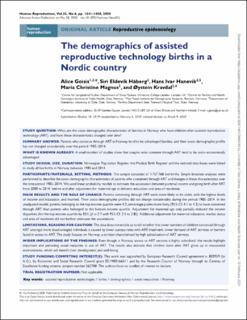| dc.description.abstract | Study question: What are the socio-demographic characteristics of families in Norway who have children after assisted reproductive technology (ART), and have these characteristics changed over time? Summary answer: Parents who conceive through ART in Norway tend to be advantaged families, and their socio-demographic profile has not changed considerably over the period 1985-2014. What is known already: A small number of studies show that couples who conceive through ART tend to be socio-economically advantaged. Study design, size, duration: Norwegian Population Register, the Medical Birth Register and the national data bases were linked to study all live births in Norway between 1985 and 2014. Participants/materials, setting, methods: The sample consisted of 1 757 768 live births. Simple bivariate analyses were performed to describe the socio-demographic characteristics of parents who conceived through ART and changes in these characteristics over the time period 1985-2014. We used linear probability models to estimate the association between parental income and giving birth after ART from 2000 to 2014, before and after adjustment for maternal age at delivery, education and area of residence. Main results and the role of chance: Parents conceiving through ART were more likely to be older, with the highest levels of income and education, and married. Their socio-demographic profiles did not change considerably during the period 1985-2014. In the unadjusted model, parents belonging to the top income quartile were 4.2 percentage points more likely (95% CI: 4.1 to 4.3) to have conceived through ART than parents who belonged to the bottom income quartile. Adjustment for maternal age only partially reduced the income disparities (for the top income quartile by 35% (β = 2.7 with 95% CI: 2.5 to 2.8)). Additional adjustment for maternal education, marital status and area of residence did not further attenuate the associations. Limitations, reasons for caution: The data does not enable us to tell whether the lower numbers of children conceived through ART amongst more disadvantaged individuals is caused by lower success rates with ART treatment, lower demand of ART services or barriers faced in access to ART. The study focuses on Norway, a context characterised by high subsidisation of ART services. Wider implications of the findings: Even though in Norway access to ART services is highly subsidised, the results highlight important and persisting social inequities in use of ART. The results also indicate that children born after ART grow up in resourceful environments, which will benefit their development and well-being. | |
